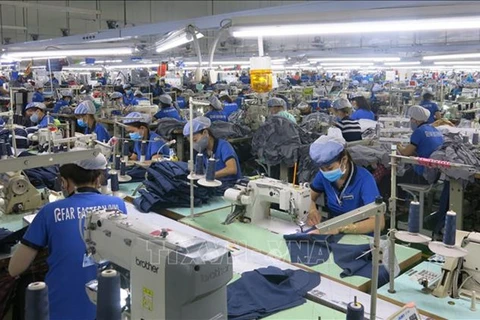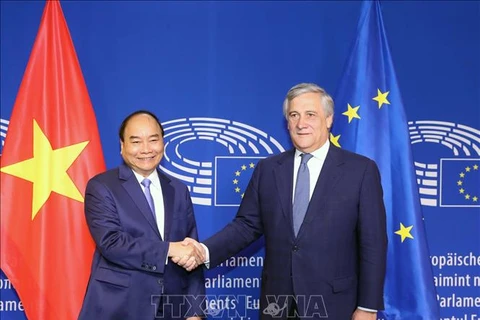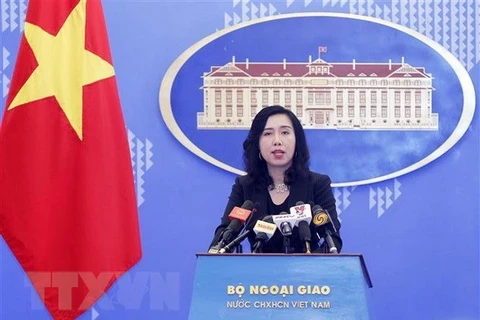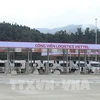Hanoi (VNA) – The free trade agreement between Vietnam and the EU (EVFTA) is expected to bring 3.2 billion USD worth of benefits to Vietnam in 2020, while helping the Southeast Asian nation expand export markets and engage deeper into the global value chain, said experts.
Negotiations for the deal have ended after six years, opening great chances for Vietnamese firms to penetrate into a promising market with a population of 508 million and total GDP of about 18 trillion USD.
Before the FTA was signed, the EU had been the third largest trade partner of Vietnam and one of the two leading export markets of the country with two-way trade reaching upwards of 50.4 billion USD in 2017.
With a commitment to cutting down import taxes by over 99 percent, the deal will bring about great chances for Vietnamese firms to strengthen exports, especially in products Vietnam holds strengths in, such as garments and textiles, footwear, agro-fishery, and timber.
In particular, products that have never been sold in the EU due to tariff barriers will be able to access the market with a competitive price.
A recent research by international experts has shown that the FTA will help increase Vietnam’s export revenue by 4-6 percent per year in the 10 years after it takes effect.
For the garment and textiles sector, the deal may help raise its exports by 1.54 billion USD by 2023 and 5.82 billion USD by 2028.
According to the Minister of Industry and Trade Tran Tuan Anh, the FTA is a high quality deal, thus the benefits it brings are high.
Vietnam’s export revenue is expected to rise 4-6 percent, while those of the economic sector will increase by 19 billion USD in 2019 and 70 billion USD in 2028.
As Vietnam and the EU’s export products and economic structures are supplementary without direct competition, the benefit from the deal is huge.
Minister Anh also held that there will be competitive pressure, including in processing, automobile manufacturing, information technology, agriculture, and animal breeding.
However, along with the opportunities, Vietnam will also face some challenges from the FTA from 2019 onwards. Enterprises who wish to export goods to the EU will have to show certificates of origin (C/O) for their products in order to enjoy the Generalised System of Preferences (GSP).
Tran Thanh Hai, Vice Director of the Department of Import-Exports under the Ministry of Industry and Trade, said that the responsibility to prove the origins of goods will switch from management agencies to exporters themselves.
This means enterprises will have to process the procedures themselves, meeting the criteria for origin certificates and bear the responsibility themselves on the accuracy of the documents.
Statistics from the Ministry of Industry and Trade showed that Vietnam already has 2,700 enterprises conducting export activities with the EU which are subject to GSP.
Hai asserted that before applying C/O regulations on Vietnamese firms, the EU should grant about six months for the firm to adapt to the new regulations.
The ministry will organise training courses for enterprises and grant licences to them to issue C/Os, he added.
On the other hand, the EVFTA will create motivation and new playgrounds for EU organisations who wish to invest in Vietnam, while contributing to the process of building modern market institutions and international economic integration in Vietnam.
Minister Anh stressed the need for Vietnamese firms to actively exploit benefits from the deal and prepare themselves for its upcoming impacts. –VNA
Negotiations for the deal have ended after six years, opening great chances for Vietnamese firms to penetrate into a promising market with a population of 508 million and total GDP of about 18 trillion USD.
Before the FTA was signed, the EU had been the third largest trade partner of Vietnam and one of the two leading export markets of the country with two-way trade reaching upwards of 50.4 billion USD in 2017.
With a commitment to cutting down import taxes by over 99 percent, the deal will bring about great chances for Vietnamese firms to strengthen exports, especially in products Vietnam holds strengths in, such as garments and textiles, footwear, agro-fishery, and timber.
In particular, products that have never been sold in the EU due to tariff barriers will be able to access the market with a competitive price.
A recent research by international experts has shown that the FTA will help increase Vietnam’s export revenue by 4-6 percent per year in the 10 years after it takes effect.
For the garment and textiles sector, the deal may help raise its exports by 1.54 billion USD by 2023 and 5.82 billion USD by 2028.
According to the Minister of Industry and Trade Tran Tuan Anh, the FTA is a high quality deal, thus the benefits it brings are high.
Vietnam’s export revenue is expected to rise 4-6 percent, while those of the economic sector will increase by 19 billion USD in 2019 and 70 billion USD in 2028.
As Vietnam and the EU’s export products and economic structures are supplementary without direct competition, the benefit from the deal is huge.
Minister Anh also held that there will be competitive pressure, including in processing, automobile manufacturing, information technology, agriculture, and animal breeding.
However, along with the opportunities, Vietnam will also face some challenges from the FTA from 2019 onwards. Enterprises who wish to export goods to the EU will have to show certificates of origin (C/O) for their products in order to enjoy the Generalised System of Preferences (GSP).
Tran Thanh Hai, Vice Director of the Department of Import-Exports under the Ministry of Industry and Trade, said that the responsibility to prove the origins of goods will switch from management agencies to exporters themselves.
This means enterprises will have to process the procedures themselves, meeting the criteria for origin certificates and bear the responsibility themselves on the accuracy of the documents.
Statistics from the Ministry of Industry and Trade showed that Vietnam already has 2,700 enterprises conducting export activities with the EU which are subject to GSP.
Hai asserted that before applying C/O regulations on Vietnamese firms, the EU should grant about six months for the firm to adapt to the new regulations.
The ministry will organise training courses for enterprises and grant licences to them to issue C/Os, he added.
On the other hand, the EVFTA will create motivation and new playgrounds for EU organisations who wish to invest in Vietnam, while contributing to the process of building modern market institutions and international economic integration in Vietnam.
Minister Anh stressed the need for Vietnamese firms to actively exploit benefits from the deal and prepare themselves for its upcoming impacts. –VNA
VNA
























